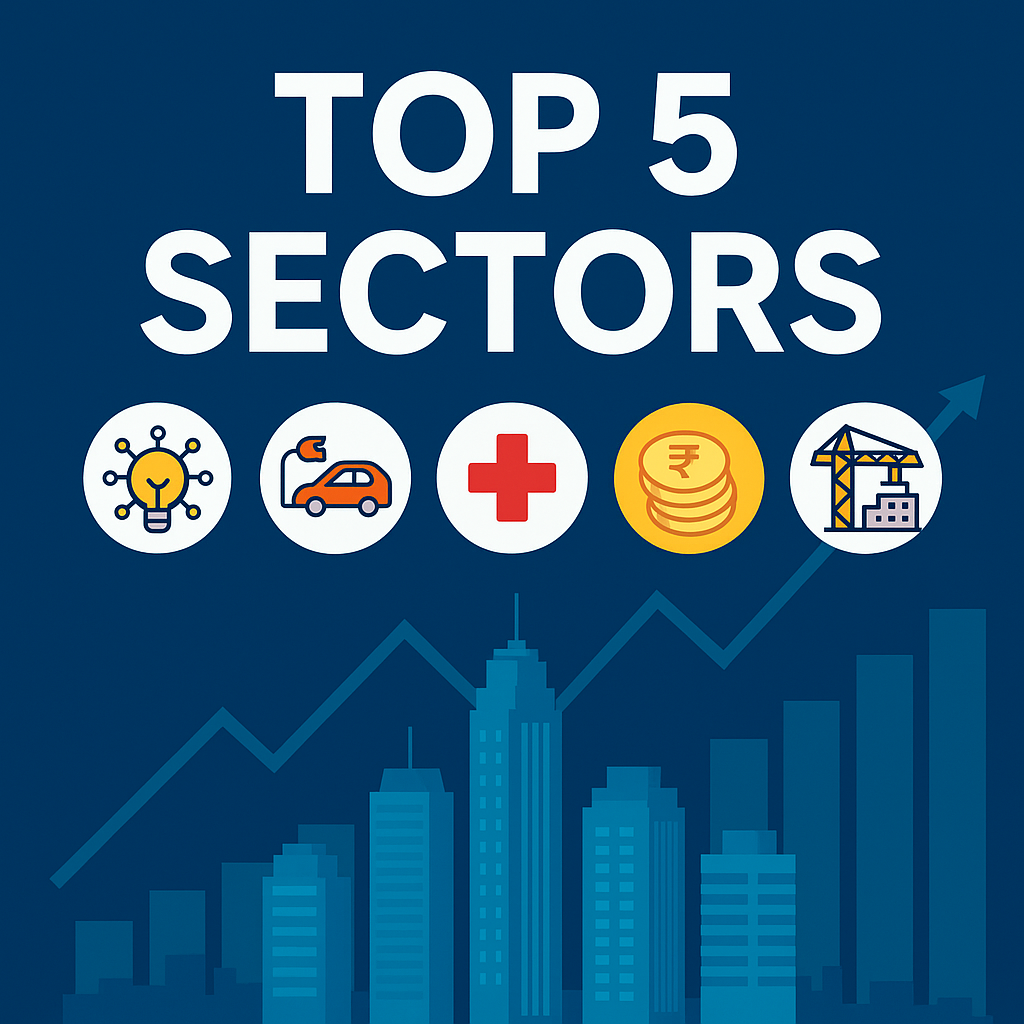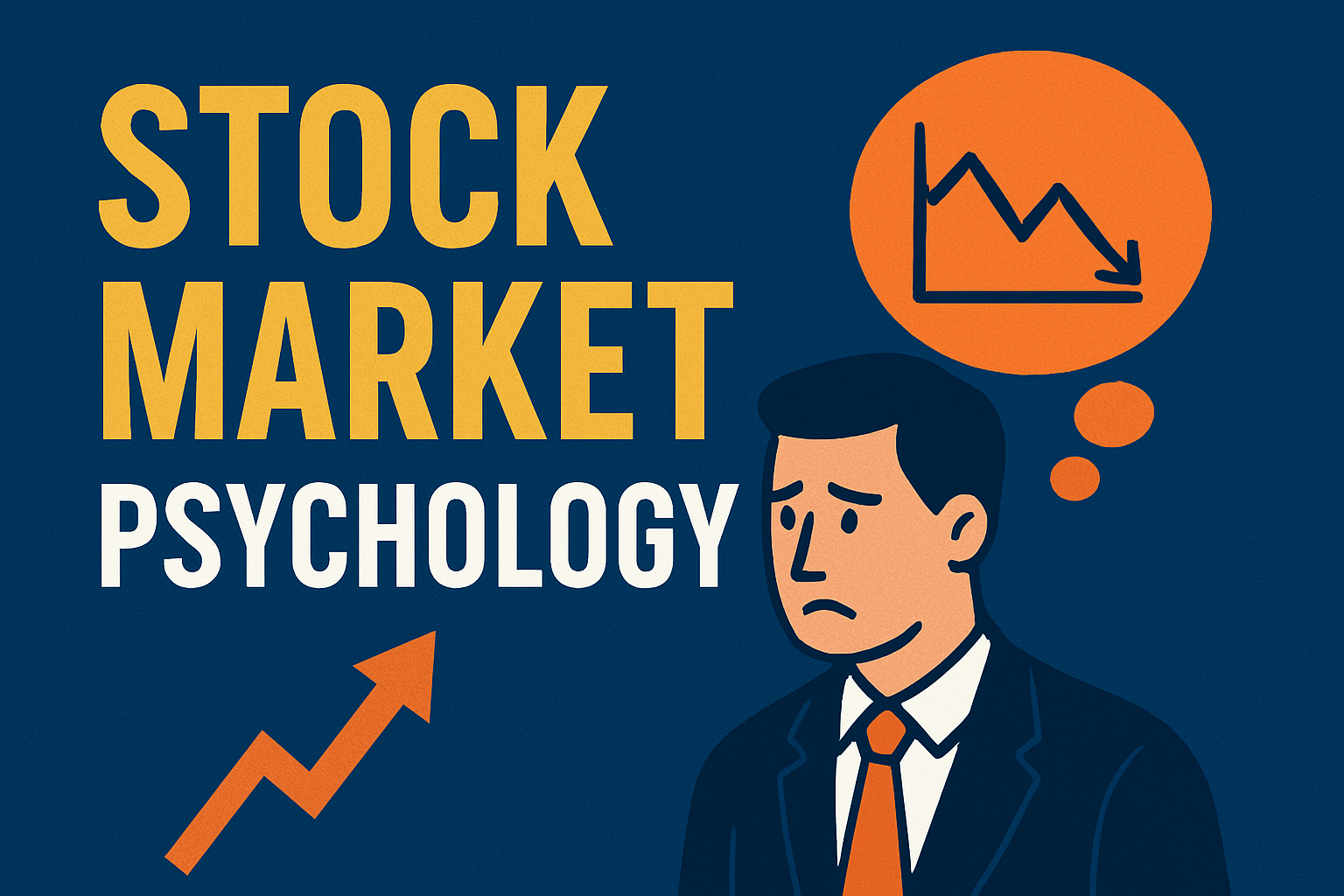Surprising fact: EV sales jumped 40.31% year over year in FY24, with registrations hitting 6.4% of all vehicle sales — a sign of big shifts across the market.
This guide lays out why sector-based allocation matters for long horizons and how structural tailwinds can shape returns over a 5–10 year window.
The macro backdrop is supportive: S&P upgraded the sovereign outlook, infrastructure capex rose in the Union Budget, and clean energy targets aim for 500 GW by 2030. Data on AI, renewables, and EVs shows demand and capacity expansion across information technology, renewable energy, healthcare, banking, and infrastructure.
Our aim is practical. We rank five high-opportunity areas, flag the main drivers and risks, and offer a framework for blending sector exposure with disciplined company selection. Expect a sector scorecard, portfolio guidance, and a company checklist later in the article.

Key Takeaways
- Structural policy and capex support create durable industry tailwinds.
- Technology, renewables & EVs, healthcare, banking, and infrastructure stand out.
- Think in 5–10 year horizons to capture compounding gains.
- Use sector allocation plus rigorous company selection for resilience.
- Data points on EV adoption, AI market growth, and infra spend back the opportunity set.
Why Sector-Based Investing Matters in India’s Future
Aligning capital at the industry level helps investors ride multi-year shifts driven by reform and digitization. Sector allocation turns policy action and broad technology adoption into a clearer investment roadmap. It captures compounding that comes when an entire industry modernizes, rather than depending on a single firm’s execution.
Structural sector exposure reduces idiosyncratic risk. When Make in India, Production Linked Incentives (PLI), and digital public infrastructure (UPI, JAM) scale, demand clarity and formalization improve across companies. That raises productivity and margin visibility for many firms at once.
Compare this with tactical stock picking: a single company can falter on execution, regulation, or supply chains. Industry-level allocation spreads those risks through diversified baskets or funds while keeping upside from broad adoption of new technologies and energy transitions.
- Sector exposure captures multi-year compounding from policy reforms and technology diffusion.
- Government initiatives create enabling environments that lift whole industries.
- Allocation across industries reduces single-company execution risk and improves demand visibility.
Finally, sector rotation allows investors to manage cyclical exposure while holding core positions in secular industries tied to manufacturing, infrastructure, energy, and digital rails. Aligning allocation with industry maturity, capital needs, and regulatory frameworks can improve risk-adjusted returns in a rapidly scaling country.
Macro Tailwinds: A Fast-Growing Economy and Demographic Dividend
A positive sovereign outlook and a young workforce are creating a sustained runway for sector-level returns. S&P Global Ratings upgraded the country outlook to positive in May 2024, which can attract foreign capital and lower funding costs for many industries.
Lower borrowing rates and fresh inflows help fund longer-duration projects in infrastructure and energy. That makes large capital-intensive investments more viable for both public and private players.
Positive sovereign outlook and capital inflows potential
Foreign funds often follow improved credit signals. New capital eases liquidity, supports valuation uplifts, and enables firms to expand capacity without prohibitive financing costs.
Young workforce, rising incomes, and digital adoption
A demographic dividend drives consumption, housing demand, and higher financial services penetration over the next five to ten years. Rising incomes and mobile-first adoption increase demand for healthcare, travel, and consumer tech.

Rapid digital uptake — AI spending projected to grow at a ~33.7% CAGR — boosts productivity across services and export-oriented IT. Data-led decision making strengthens competitive moats and improves margins for scalable firms.
| Macro Factor | Mechanism | Sector Impact |
|---|---|---|
| Positive sovereign outlook | Attracts capital, lowers funding costs | Infrastructure, manufacturing, energy |
| Demographic dividend | Higher consumption and workforce supply | Housing, financial services, retail |
| Digital adoption | Productivity gains and analytics | IT services, fintech, healthcare |
| Capacity expansion | Power and transport upgrades | Logistics, manufacturing, energy transition |
Bottom line: These macro tailwinds combine to create a favorable backdrop for disciplined sector allocation. Patient investors who hold through cycles are positioned to capture compounding returns as markets expand and capacity scales.
Government Catalysts: Make in India, PLI Schemes, and Digital Public Infrastructure
Government programs are creating clearer incentives for companies to build local supply chains and digital services. These moves link policy, capital, and execution so industry capacity scales more predictably.
Manufacturing push: PLI-backed capacity and supply chain localization
PLI schemes de-risk heavy capex by tying incentives to output. That attracts global firms and spurs domestic plants that lower costs and shorten lead times.
The Make in India aim is to lift manufacturing’s share of GDP and support jobs and exports. Fiscal support — including a higher infrastructure capex of Rs 11.11 lakh crore — backs projects in roads, rail, airports, logistics, and power.
Digital rails: UPI, JAM stack enabling fintech and services growth
Digital public infrastructure such as UPI and the JAM trinity reduces friction and expands financial inclusion. UPI-led payments have scaled fintech innovation and platform services across urban and rural markets.
“Policy alignment that pairs physical projects with digital rails creates more investable opportunities for firms that execute well.”
- PLI incentives help build local component ecosystems for energy, EVs, and electronics.
- Make in India and government initiatives attract both foreign and domestic investments into manufacturing clusters.
- Continued public capex can crowd in private capital and boost competitiveness of regional industry hubs.
Technology & IT Services: Cloud, AI, and Digital Transformation
Enterprise demand for cloud, AI, and platform services is reshaping how Indian firms scale and charge for value. Rapid migration of workloads, rising AI/ML adoption, and stronger cybersecurity needs justify a top-tier placement for this area.

Growth drivers
Cloud migration, AI/Big Data/IoT, cybersecurity, and analytics form multi-year demand engines for services companies. Remote delivery models expanded global capacity and helped margins by improving utilization.
Indicative outlook
Leading companies are moving from low-cost outsourcing toward product-adjacent offerings and platforms. That mix shift supports sustained double-digit momentum as clients modernize apps and infrastructure.
Risks and stock selection
Watch wage inflation, talent shortages in AI and security, and pricing pressure during slowdowns. For picks, favor firms with rising deal wins, strong order books, growing share of cloud/AI services, and diversified end markets.
“Quality IT services stocks can serve as core holdings for compounding exposure to global digitization.”
- Metrics: deal pipeline, revenue mix in cloud/AI, EBITDA margins, and free cash flow.
- Equity angle: firms that convert services into recurring products earn stickier relationships and better pricing power.
Renewable Energy & Electric Vehicles: India’s Green Energy Supercycle
Policy clarity and falling hardware costs are unlocking a multi-year expansion across power and mobility. Renewables and electric mobility now show clear capex visibility and demand signals.
Policy tailwinds
Targets and incentives include a 500 GW clean energy goal by 2030, FAME II for EVs, and ACC-PLI for advanced batteries. These measures push manufacturing and attract new investments.
Market metrics
Installed renewable capacity rose from 76.38 GW (2014) to 203.1 GW (2024), signalling rapid expansion. EV sales reached 1,752,406 units in FY24, up 40.31% YoY and ~6.4% of vehicle sales.
Value chain opportunities
- Developers: utility-scale solar, wind project rollout.
- OEMs and suppliers: electric vehicles, batteries, power electronics.
- Infrastructure: charging networks and grid upgrades.
Key risks
Watch policy delays, grid integration limits, and import dependence for critical minerals. Tariff swings for modules and components can pressure project economics.
| Area | Signal | Equity angle |
|---|---|---|
| Renewable capacity | 203.1 GW (2024); 500 GW target | Utilities, developers, EPC firms |
| EV adoption | 1.75M units FY24; +40.31% YoY | OEMs, battery makers, charging providers |
| Manufacturing push | ACC-PLI, local incentives | Component makers, module assemblers |
| Risks | Grid, policy, raw materials | Focus on execution track record and balance-sheet strength; selective stocks |
Healthcare & Pharma: Rising Demand and Export Competitiveness
Greater health awareness and digital access are widening the addressable patient base for providers. That shift supports steady demand across outpatient care, diagnostics, and elective procedures.

Domestic drivers
An aging population, higher insurance penetration, and expanding hospital networks lift utilization. Urban and rural clinic rollouts improve access and reduce treatment delays.
Telemedicine and digital records cut friction and raise efficiency for care delivery. That expands reachable patients and helps companies scale services faster.
Export engines and product mix
Indian pharma keeps an edge in generics while moving up the value chain into specialty and complex generics. Rising filings and niche APIs improve margins and make revenues more durable.
Opportunities and risks
- Areas to watch: diagnostics chains, med‑tech suppliers, API/intermediate makers, and hospital operators expanding beds.
- Regulatory compliance in key export markets is a material risk. Prioritize firms with proven quality systems and inspection track records.
Selection metrics for companies
Focus on: resilient cash flows, diversified revenue, robust pipelines or filings, and clear product mix shifts toward higher value products.
“Healthcare can serve as a defensive-growth sector, balancing cyclical exposures while offering steady expansion potential.”
Banking & Financial Services (BFSI): Digital Banking and Fintech Scale
Payments, lending, and embedded finance are converging on a single set of digital rails that unlock new customers at scale.
Engines of growth: A credit upcycle, formalization, and UPI/JAM-led digitization expand volumes across banks, NBFCs, payments firms, and fintech platforms.
Opportunities and market whitespace
Retail credit, MSME lending, wealth-tech, and insure-tech show large untapped demand as incomes and savings rise. Embedded finance and account aggregation enable new products and faster customer onboarding.
Risk lens
Asset quality (NPAs) can sour quickly in downturns. Regulators may change rules, and funding costs can swing for non-deposit lenders. Strong risk frameworks and capital buffers matter.
Selection cues
- Prefer firms with sticky deposit franchises and diversified fee income.
- Look for superior underwriting data and technology that trims operating costs.
- Balance exposure across lenders, payments, brokers, and insurers to reduce cyclicality.
“DPI-driven scale makes the BFSI market a lever for broader economic participation.”
Infrastructure & Real Estate: Urbanization and Nation-Building Projects
Public capex programs are laying rails for a sustained upgrade of cities, transport links, and logistics hubs.

Budgeted pipelines and flagship works
The Union Budget raised capital outlay by 11.1% to Rs 11.11 lakh crore. Major projects include Bharatmala highways, the Dedicated Freight Corridor, airport expansion, and smart city builds.
Real assets cycle and multiplier effects
Sustained public spending boosts demand for housing, building materials, and engineering services. Industrial parks and warehousing grow as manufacturing and e-commerce expand capacity.
Execution, leverage, and selection cues
Capital intensity and land issues raise execution risk. Project delays and high leverage can erode returns.
- Favor companies with diversified order books and strong balance sheets.
- Prefer developers with branded projects, low-cost land banks, and prudent cash management.
- Look for firms with visible pipelines across geographies and government-backed workflows.
“Infrastructure-linked businesses benefit from stable pipelines and improved performance visibility when execution and finances are strong.”
| Area | Signal | Equity cue |
|---|---|---|
| Transport capex | Bharatmala, DFC, airports | Contractors with project wins and healthy cash flows |
| Real estate | Urban migration, affordability | Developers with brand, land bank, low leverage |
| Logistics | Warehousing demand | Grade A asset owners, REIT candidates |
Sector Scorecard: Drivers, Risks, and Long-Term Potential at a Glance
Below is a concise comparison that maps what fuels each industry and what could derail performance.
Tech & information technology
Drivers: AI, cloud, cybersecurity, and steady global outsourcing demand.
Risks: talent shortages and pricing pressure.
Long-term potential: high — services are shifting toward AI-led, higher‑margin products.
Renewable energy & EV
Drivers: policy push, falling hardware costs, and corporate ESG commitments. Targets include 500 GW clean capacity by 2030.
Risks: policy delays and grid integration challenges.
Long-term potential: high as capacity and power demand expand across solar wind and storage chains.
Healthcare & pharma
Drivers: rising domestic demand and export competitiveness.
Risks: regulatory scrutiny in export markets.
Long-term potential: high with specialty products and scaled services.
BFSI
Drivers: digital public infrastructure, credit penetration, and a growing fintech market (~$420B by 2029).
Risks: NPAs and regulatory shifts.
Long-term potential: medium‑high as financialization deepens.
Infrastructure & real estate
Drivers: urban migration and elevated capex (Rs 11.11 lakh crore), which support steady pipelines.
Risks: capital intensity and execution delays.
Long-term potential: medium‑high with durable demand for transport, logistics, and housing.
“Technology enablement, policy alignment, and operating leverage are the common levers that drive returns across these industries.”
| Area | Key drivers | Main risks | Indicative potential |
|---|---|---|---|
| Tech & IT | AI, cloud, global demand | Talent, pricing | High |
| Renewable energy & EV | Policy push, cost curves, ESG | Policy delays, grid limits | High |
| Healthcare & Pharma | Domestic demand, exports | Regulation | High |
| BFSI | DPI, credit penetration, fintech | NPAs, rules | Medium‑High |
| Infrastructure & Real Estate | Urban growth, public capex | Capital needs, execution | Medium‑High |
How to use this scorecard: Balance exposure by risk appetite and horizon. Blend tech and renewable energy for higher upside, and add BFSI or infrastructure for steadier performance and income.
Projected Growth: Indicative CAGRs and Timelines to Watch
Projected trajectories help translate big-picture policy into actionable timelines for tracking sector milestones. These indicative paths show when capacity, adoption, and earnings should start to matter.
EV market
Electric vehicles sales hit 1.75 million in FY24, up 40.31% year‑on‑year. Continued high double‑digit CAGRs are likely over the next 5–7 years as two‑ and three‑wheelers, commercial fleets, and charging rollouts scale.
Watch vehicle registrations, charging milestones, and incentive changes as near‑term catalysts.
AI spending and IT services
The Indian AI market is forecast at ~33.7% CAGR through 2027. That pace supports a meaningful mix shift within IT services toward higher‑value AI and automation projects and can lift margins for firms that capture early deals.
Renewables
Renewable energy capacity must accelerate to reach a 500 GW target by 2030. Monitor tender volumes, module pricing, and grid upgrades—these determine the cadence of yearly additions and project commissioning.
Other timelines: infrastructure capex underpins construction pipelines; BFSI expansion will track credit cycles and NIMs year by year; healthcare leaders may show mid‑teens earnings uplifts as specialty ramps complete.

“Track quarterly order inflows, commissioning data, and regulatory updates to align allocations with real progress.”
Portfolio Strategy: Diversify Across Sectors for Resilience
Balancing steady engines with cyclical plays strengthens portfolio resilience across market swings.
Core-satellite approach across cyclical and secular leaders
Core capital should sit in secular areas that compound: Tech & IT, Healthcare & Pharma, and Renewables/EV. These act as durable anchors and aim to deliver steady returns.
Satellite exposure can target cyclical pockets such as Infrastructure & Real Estate and select BFSI names tied to DPI and capex cycles. These add upside when policy or spending accelerates.
- Diversify across the five core industry themes and within each: large caps plus quality mid-caps to manage idiosyncratic risk.
- Use a mix of direct stock picks and funds for efficient implementation; prefer firms with strong governance and proven execution among companies.
- Rebalance periodically to keep target weights and to lock gains after sector rallies. Position sizing and stop rules help control downside.
- Align allocations with risk profile, time horizon, and liquidity needs so investors can stay the course through cycles.
“A disciplined core-satellite plan, with active risk checks and timely rebalancing, is the most practical way to harvest structural market moves while limiting shocks.”
How to Pick Strong Companies Within Each Industry
Identifying resilient businesses starts with measurable moats and repeatable unit economics. Use clear metrics and recent execution as your baseline.

Moats, metrics, and cash flow
Assess moats: look for proprietary tech, switching costs, network effects, or brand strength. Check R&D intensity and innovation pace for product and product‑adjacent firms.
Order book & KPIs: review backlog, conversion rates, and client concentration to judge revenue visibility. Stress-test working capital, unit economics, and free cash flow across cycles.
Policy fit and execution record
Confirm alignment with relevant programs and the firm’s ability to capture incentives. For renewables/EV, examine project portfolios, balance‑sheet strength, and regulatory exposure.
For IT services, assess migration to cloud, AI, and cybersecurity offerings and the share of higher‑value services. Scrutinize governance, capital allocation, and past performance through downturns.
- Use data-driven KPIs: margin trends, ROIC vs. WACC, customer additions, and product mix upgrades.
- Balance growth with valuation discipline; avoid overpaying when market enthusiasm runs hot.
“Select companies that show repeatable cash conversion and a proven path for scaling performance.”
Invest with a Future Lens: 5-10 Year Horizons
A patient horizon lets structural shifts compound into material gains for careful allocators.
Think multi-year and accept near-term volatility as part of the path toward larger rewards. AI spending is growing at a high CAGR through 2027, and steady infrastructure capex provides visible project timelines across several years.
Riding the structural story through cycles
Stay invested. Hold core exposure across chosen sectors and add shares of quality names on meaningful pullbacks. This lets compounding work for you as adoption curves steepen.
Set milestone reviews tied to policy targets and project commissioning. Examples: 2030 energy capacity targets and major infrastructure completion dates. Use these checkpoints rather than daily price moves to guide adjustments.
“Patience and disciplined allocation compound advantages as market adoption accelerates.”
- Keep a 5–10 year perspective to capture compounding across policy, technology, and capital cycles.
- Add selectively on weakness in proven companies with strong cash conversion.
- Review progress at predefined milestones and rebalance when necessary.
Conclusion
, Sector alignment helps translate policy and technology shifts into clearer portfolio outcomes.
Recap: Focus your allocation on five core themes: Technology & IT Services; Renewable Energy & EV; Healthcare & Pharma; BFSI; and Infrastructure & Real Estate.
Structural tailwinds are real. Clean energy plans target 500 GW by 2030. EV sales rose ~40% year‑on‑year in FY24. Public capex supports steady expansion across roads, power and logistics.
Use disciplined diversification, regular rebalancing, and rigorous company selection. Favor firms with visible order books, strong cash conversion, and clear policy alignment.
Final note: Adopt a 5–10 year view. Sector allocation plus careful stock choices can turn these opportunities into measurable returns while managing risk.
FAQ
What macro factors make India attractive for sector-focused portfolios?
India’s strong demographics, improving sovereign metrics, and steady capital inflows create a supportive backdrop. A young workforce, rising incomes, and rapid digital adoption fuel consumption and services growth. Together, these structural drivers help sectors with secular demand—technology, clean energy, healthcare, finance, and infrastructure—grow over multi-year horizons.
How do government programs shape industry opportunities?
Programs such as Make in India, Production Linked Incentive (PLI) schemes, and expanded digital public infrastructure (UPI, Aadhaar-linked services) lower barriers and accelerate capacity building. PLI supports manufacturing scale-up, while digital rails enable fintech, telemedicine, and e-commerce expansion—creating clearer policy-driven revenue pools for firms across value chains.
Why focus on cloud, AI, and cybersecurity within IT services?
Global digital transformation is shifting spending to cloud migration, AI/ML projects, and security. Indian IT firms that add higher-value services see better margins and client stickiness. These themes help move revenues from commoditized outsourcing toward consulting, product engineering, and IP-led offerings, supporting double-digit industry growth.
What makes renewables and electric mobility compelling for investors?
Ambitious clean-energy targets and EV incentives support rapid capacity additions across solar, wind, batteries, and charging infrastructure. Declining costs and technology improvements strengthen economics. This creates opportunities across project developers, equipment manufacturers, battery makers, and charging-network providers, though execution and grid integration remain risks.
How should one evaluate healthcare and pharmaceutical firms?
Look for companies with strong R&D pipelines, regulatory compliance, diversified export markets, and resilient domestic demand. Firms supplying complex generics, specialty products, or contract development and manufacturing (CDMO) services often capture higher margins and export growth, benefiting from global supply-chain shifts.
What drives growth in banking and financial services now?
Digital payments, UPI-led ecosystems, and embedded finance expand customer access while retail credit and MSME lending rise with consumption and capex. Fintech scale-ups and traditional banks that modernize platforms can capture fee revenue and lending growth. Monitor asset quality, interest-rate cycles, and regulatory changes closely.
Where does infrastructure and real estate offer the most upside?
National capital expenditure on highways, rail corridors, airports, and smart-city projects boosts project pipelines and demand for industrial parks and logistics properties. Residential demand remains strong in many urban centers. However, returns depend on execution, land availability, and financing costs, so pick firms with delivery track records.
What are common risks across these thematic plays?
Key risks include policy delays or reversals, raw-material shortages, supply-chain disruptions, currency volatility, and execution failure. Sector-specific issues—like talent shortages in tech or grid constraints for renewables—can also impair performance. Diversification and active monitoring help mitigate these risks.
How should investors balance sector exposure within a portfolio?
Use a core-satellite approach: keep core holdings in broad-market or diversified funds and add satellite positions in secular leaders across technology, clean energy, healthcare, finance, and infrastructure. Rebalance periodically, align holdings with risk tolerance, and maintain a 5–10 year horizon for structural themes to play out.
What metrics matter when selecting companies inside each industry?
Prioritize sustainable cash flow, margin trends, R&D or capex intensity where relevant, order-book visibility, return on invested capital (ROIC), and balance-sheet strength. Also assess management execution, policy alignment, and competitive moats like patents, network effects, or scale advantages.
Which timelines and growth rates should investors watch for electric vehicles and renewables?
Expect EV adoption to follow high double-digit CAGRs through the decade in key segments, driven by subsidies, total-cost-of-ownership parity, and charging buildout. Renewable capacity additions are set to accelerate toward national targets by 2030, driven by falling levelized costs and policy support—watch project pipelines and manufacturing localization timelines.
How can small investors gain exposure if they lack sector expertise?
Consider sector-focused mutual funds or ETFs managed by experienced teams, or diversified funds with higher allocations to the themes you favor. These products reduce single-stock risk and provide professional research coverage while allowing you to express a thematic view.










Comments 1